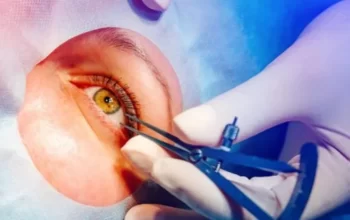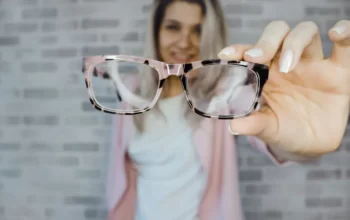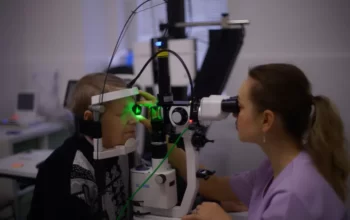
Your eyes stay lubricated and debris-free thanks to blinking. Without this reflex, which occurs roughly every four seconds, your eyes would be extremely dry and painful. A tear film is released when you blink, which helps keep the surface of your eyeball smooth. You won’t experience blurry vision thanks to the smooth surface’s ability to focus light.
How We Blink Our Eyes
The blinking reflex is under the control of several muscles. Your upper eyelid houses the primary muscles involved in blinking. Levator palpebrae superioris and orbicularis oculi are the muscles in question.
Your eyelid opens as a result of the levator palpebrae superioris muscle contracting. It is closed by the orbicularis oculi. Your eyes can be made wider by the superior tarsal muscle, also known as the Muller’s muscle, which is located in the upper eyelid, and the palpebral muscle, which is situated in the lower eyelid.
All of these muscles work together in a semi-autonomous manner to blink. Additionally, the muscles are necessary for other eye movements like squinting and winking.
There are three different types of blinking: reflex, reflex, and voluntary.
- Spontaneous Blinking: Both internal and external stimuli are not necessary for it to occur. Similar to breathing or digestion, this type of blinking occurs unconsciously.
- Reflex Blinking: This is a reaction to outside stimuli, such as foreign objects that come into contact with your cornea or appear close to your eye. It happens quicker than a natural blink.
- Voluntary Blinking: All the relevant muscles are used during a deliberate blink.
Why We Blink Our Eyes
Using your tears and an eye-secreted lubricant, blinking lubricates your eyes through corneal irrigation. Aside from that, blinking shields your eyes from irritants and foreign objects.
The majority of foreign matter and potential irritants are stopped before they can enter your eyeball by your eyelashes when you blink. The eyelashes act as a barrier between the wearer and foreign objects like dust and other elements.
Researchers think that blinking may have additional functions because it happens more frequently than is required to keep your eyes lubricated. Blinking, according to some researchers, might aid in attention disengagement.
According to research, the voluntary control of your visual perception of the spatial relationships of objects is exerted by your dorsal network, which experiences a reduction in cortical activity when you blink. The default-mode network, which is active when you are not paying attention to the outside world, experiences an increase in cortical activity at the same time.
What Happens When You Can’t Blink?
Depending on whether just one or both facial nerves are affected, people with facial nerve palsy are unable to blink with either one or both eyes. I’ve experienced my fair share of eye problems because I was born with facial palsy. I inquired with the landlord about the presence of air conditioning when the charity set up shop in its first offices in May 2015. When I said I was happy about this, they apologized that there wasn’t and gave me an odd look. I’ve gone to the movies or a play so many times, and every time the air conditioning was on, it hurt my left eye and ruined the experience. The immediate pain is obviously alleviated in some cases of facial palsy by the lack of sensation in the eye, but if you don’t feel pain, you won’t notice when your eye is getting too dry because you won’t be aware of any symptoms. In this situation, the person’s eyesight is in danger of declining. A friend who has facial palsy and no sensation in the eye that is affected works around machinery and must be extra careful because he wouldn’t feel anything if it fell into his unblinking eye.
My eye has suffered greatly this winter because of the cold and the long hours I’ve spent working on the computer moving content to our new website. I’ve had to return to taping my eye shut to get some sleep. Even with the best instructions in the world, I frequently have to remove the tape and start over because it is too uncomfortable. Taping is not as simple as it may seem.
I decided to ask our community on Facebook about all the ways having a non-blinking eye(s) affects their daily lives because after having facial palsy for a while, we tend to stop thinking about all the things we need to do to take care of our paralyzed eye(s). Unsurprisingly, there were a lot of comments.
Are You Blinking Enough?
You can get better at blinking with practice, just like any other skill! The idea of “practicing” blinking might seem silly, but with daily training sessions, you’ll become much more conscious of when and how you’re blinking (and more importantly, when you’re not). Set aside a few one-minute blinking sessions per day, and use these quick minutes to “power blink.” During each minute-long exercise, aim to blink 50 times while taking care to look in various directions (up, down, left, and right). Be sure to fully close your eyes without squeezing them; do this naturally.
You might notice a difference in your eyes, head, and possibly even your energy levels once you start blinking more effectively (say that three times fast). That’s because the more we rely on technology, the more likely we are to experience eye strain and eye fatigue, which can be prevented or treated by blinking. The American Optometric Association reports that 71% of adults use a computer or other electronic device for up to seven hours every day. Furthermore, 61% of us read on a smartphone or other device rather than a printed book. It’s understandable that so many patients experience eye strain, eye fatigue, and dry eyes given how much time they spend glued to a screen.
Any amount of time spent staring at a screen prevents you from blinking as frequently as you would otherwise. Additionally, you’re more likely to experience dry eyes, tension headaches, and even eye infections if you don’t blink. Make sure to take a 20-minute break for your eyes and mind every so often to help avoid this. Just take a 10-second break from the screen and shift your attention elsewhere. Trying to maintain awareness of how frequently you blink is another smart move.

Try Blinking Exercise
We decrease the amount of nutrition we are giving our eyes if we don’t blink enough frequently. Additionally, you might make dry eyes more likely. Lack of moisture in the eyes can result in discomfort or vision problems. Because contaminants are more likely to get into the eyes when we blink less frequently, this reduced oxygen supply can also increase our susceptibility to eye infections. The cornea could swell if our ability to breathe was completely cut off, which would happen if we stop blinking.
But you can teach yourself to blink more often, just like most habits. Implementing a few 60-second power-blinking sessions throughout the day is advised by experts at the Advanced Vision Institute. Try to blink 50 times in a minute during these sessions, while also shifting your gaze left, right, up, and down. Ensure that each time you blink, you are closing completely and not just partially. Just be careful not to close your eyes too tightly. Those who use computers frequently, in particular, might experience less eye fatigue and strain.
In order to rule out an eye infection or an underlying medical condition, Healthline advises speaking with your doctor if you experience changes in how frequently you blink along with symptoms like redness, pain, light sensitivity, discharge, swelling, blurred vision, problems with balance, or muscle spasms.
Things That Affect Blinking Frequency
Your blink rate can vary depending on a number of variables, including your age and habits like screen use. Several factors can influence how frequently someone blinks.
Age and Blinking Frequency
Babies only blink twice per minute. Through adolescence, the rate of blinking increases to about 15 times per minute and remains constant throughout life.
Children who blink a lot may have vision issues. These issues could be related to the eyes or the vision, such as allergies, dry eyes, pink eye (conjunctivitis), or a scratch on the cornea. It might also imply that they have a foreign object in their eye.
Visit the eye doctor with your child if they are frequently blinking.
Screen Use and Blinking Frequency
When focusing on or working in front of a digital screen, our blinking pattern is altered. According to studies, when you are staring at a screen, your blink rate is about one-third higher than it would be otherwise.
For instance, if you typically blink 900 times per hour, working on a laptop or using a smartphone to play a game would cause you to blink only 300 times. When you blink while looking at a screen, you also frequently do not completely close your eyes.
Sleepiness and Blinking Frequency
When you’re tired, do you blink more? According to research, people with irregular sleep patterns or sleep deprivation blink 20 to 30 times per minute. As a result, when you are tired, you may blink twice as much.
Eye Or Health Conditions and Blinking Frequency
The quantity of your blinking can also be impacted by other eye and health issues. For instance, conditions like an eye infection or a scratch on the cornea may result in more frequent blinking.
Uncontrollable blinking or twitching of the eyelids are symptoms of the blepharospasm condition. Blepharospasm can be treated with Botox injections or surgery, but doctors are unsure of what specifically causes it. In addition, many more common conditions like dry eyes, stress, and excessive caffeine consumption can also contribute to eye twitching.
Blinking more frequently may also be a symptom of certain medical conditions. For example, a type of epileptic seizure — petit mal seizures or “absence seizures” — may cause rapid blinking.
Excessive Blinking
Blinking too much happens when your blinking reflex is overstimulated. Eye irritability, eyestrain, vision issues, and neurological conditions are a few of the causes. Specifically:
- Eye irritation: Blinking occurs more frequently when there are eye irritants present, such as dust, chemical vapors, pollen, smoke, and foreign objects. Inflammation, dry eyes, ingrown eyelashes, and injuries to the eyes are additional causes of eye irritation.
- Eyestrain: Excessive blinking may be a sign of eyestrain from sustained focus. It can be brought on by extended screen time, extended reading, and exposure to bright light.
- Vision problems: Myopia, hyperopia, and presbyopia are just a few examples of eye conditions that can cause frequent blinking.
- Neurological conditions: Frequent blinking may occasionally be a symptom of certain neurological disorders, such as Wilson’s disease, Tourette syndrome, and multiple sclerosis.
Blinking more frequently than desired, which impairs your vision or daily activities, is one of the first symptoms of excessive blinking. The average adult human blinks 12 times per minute, with each blink lasting about a third of a second. Your excessive blinking reflex may be present if your blink rate is noticeably higher than this.
Depending on the cause, excessive blinking may end spontaneously. Based on the underlying causes, different treatments are available. Avoiding irritants and treating the underlying causes of eye irritation are advised. Reducing exposure to the causes of eye strain is a treatment method. The associated excessive blinking may stop if vision issues are fixed.
Should You Blink More Often?
The majority of people spend at least some of each day using screens, including TVs, laptops, and smartphones. This suggests that you’re probably not blinking as frequently as you should. Your eyes can stay healthy if you make an effort to take a break from what you’re doing and blink.
While you’re in front of a screen, you can schedule brief breaks to keep your eyes moist. If you find yourself gazing at a screen for more than 20 minutes at a time, blink for a few seconds and set a timer if necessary.
Open and close your eyes slowly ten times while taking a break from the screen. Make sure you do “full blinks” by closing your eyes and pausing in order to fully distribute the tears over your eyes.
To keep your eyes moist, try to blink more frequently. You can avoid digital eye strain and dryness-related eye irritation by doing this.
Conclusion
Consider simply closing your eyes for brief periods of time when your vision isn’t required if you feel like you’re not blinking frequently enough. This could be done in the elevator, during a TV commercial break, or while you’re considering how to reply to an email.
FAQs
Why Do Our Eyes Blink?
Reflexive blinking is a reaction to outside stimuli, such as an object in front of your eyes or a foreign object in your eye. You may blink due to dry eyes and eye strain.
What Occurs If We Don’t Blink?
The main consequence of not blinking is dry eyes, which can eventually impair your vision.
Why Do We Simply Blink Without Reason?
The majority of blinking is an unconscious reflex. Your autonomic nervous system, which regulates bodily functions in an unconscious manner, is in charge of it.



